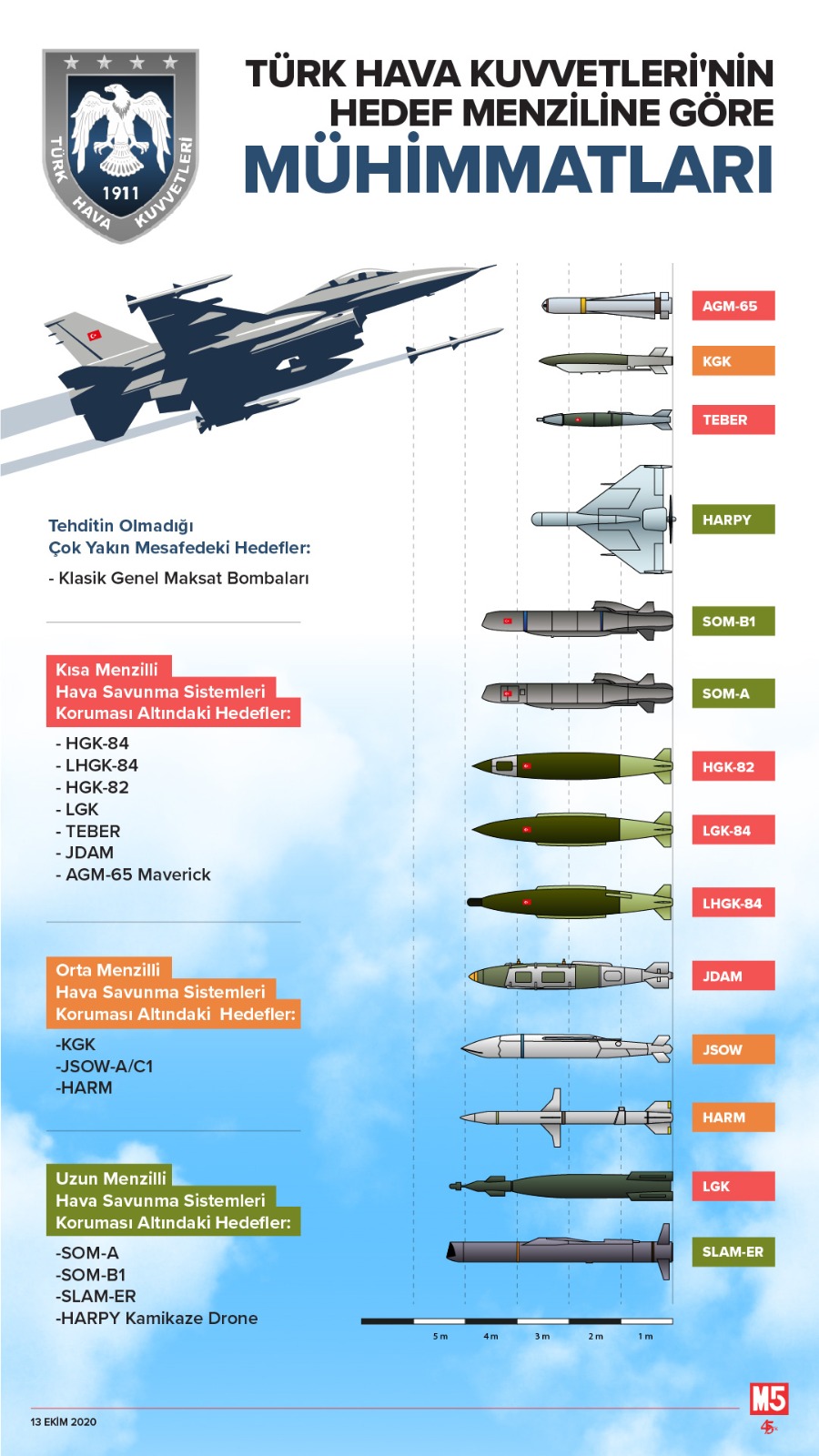Lets take a break and catch some breath please.
You are using an out of date browser. It may not display this or other websites correctly.
You should upgrade or use an alternative browser.
You should upgrade or use an alternative browser.
Turkish F-16 Knocks Down Target Drone With New Indigenous Air-To-Air Missile
Turkey’s plan to introduce indigenous new-generation air-to-air missiles has reached an important milestone with the first successful air launch of the short-range Bozdoğan weapon. A Turkish Air Force F-16C Block 40 fighter jet recently fired one of these missiles, destroying a Turkish Aerospace Şimşek high-speed target drone. The heat-seeking Bozdoğan, developed under a two-part air-to-air missile program by TÜBİTAK Defense Industries Research and Development Institute, or TÜBİTAK SAGE, is intended to arm Turkish F-16s, and Turkish Aerospace’s forthcoming Hürjet advanced jet trainer and light attack aircraft, as well as the future TF-X advanced fighter jet.Reports from Turkey indicate that the initial air-launch test of the Bozdoğan — Turkish for merlin, a small bird of prey — was carried out at the missile test range in the country’s Sinop province, on the Black Sea coast. This is the same facility that hosted trials of the Russian-made S-400 surface-to-air missile system last year. The F-16 came from the Turkish Air Force’s 401 Squadron, the service’s test unit. According to the Defence Turkey website, the missile launch and engagement sequence was monitored both from the ground and by accompanying F-16s, at least one of which carried a Sniper targeting pod.
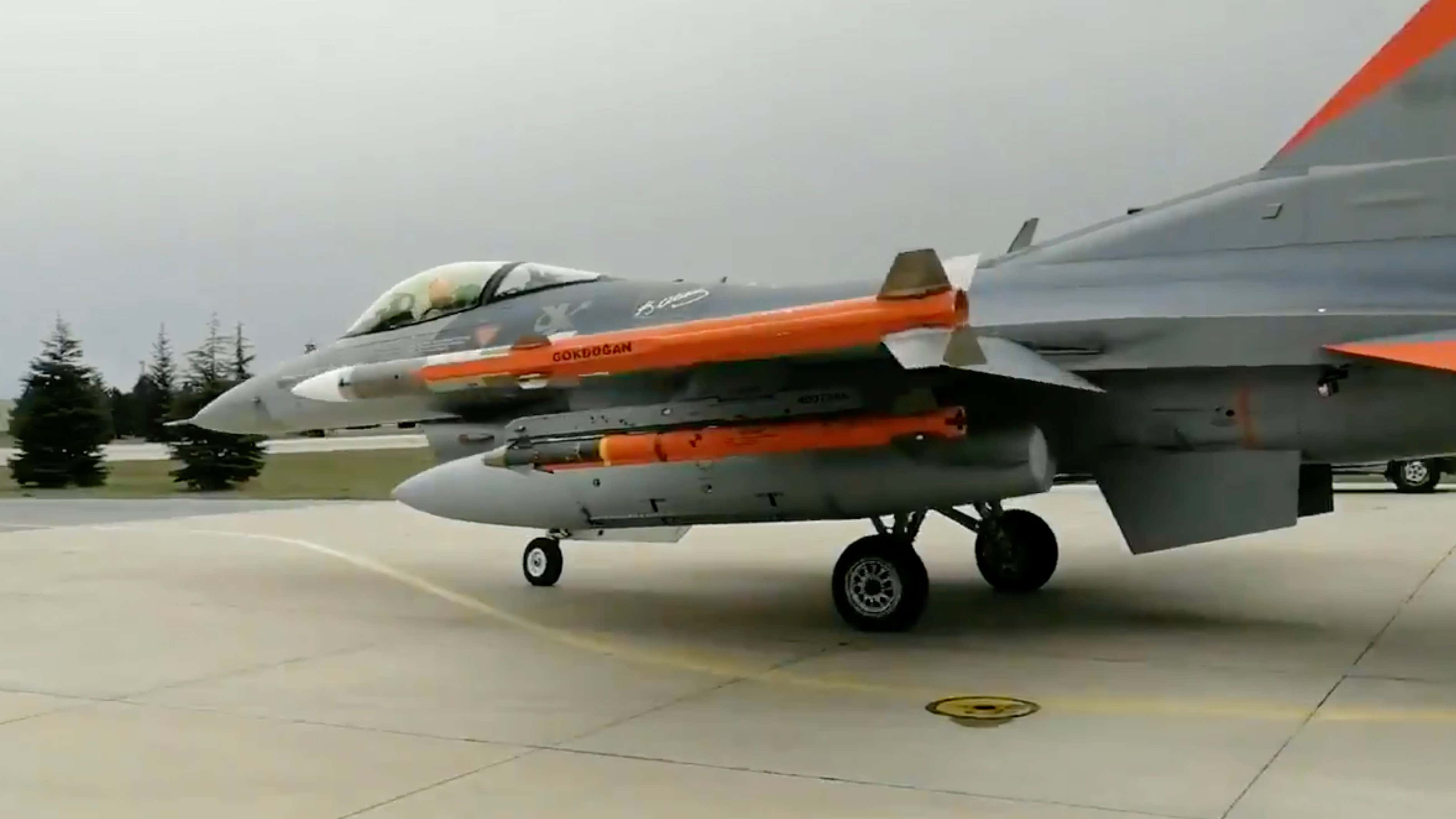
TURKISH DEFENSE INDUSTRY SCREENCAP
An F-16C test jet armed with the short-range Bozdoğan under the wing, and the medium-range Gökdoğan on the wingtip station.
Video released showing the test reveals that the Bozdoğan’s infrared seeker head locked onto the target drone at around 9 miles and was launched at a distance of between 3 and 5 miles from the target.
President Recep Erdoğan announced the successful missile test on Twitter yesterday, sharing a video and noting that Turkey had now joined a select group of countries that have successfully developed air-to-air missile technology.
The Bozdoğan, which is broadly similar in appearance to the latest AIM-9X Sidewinder, features a high-resolution dual-color imaging infrared (IIR) seeker. Like other missiles in its class, it offers a high off-boresight capability, thrust-vectoring controls, and its seeker has a high degree of discrimination to defeat flares and other countermeasures systems, according to the manufacturer.
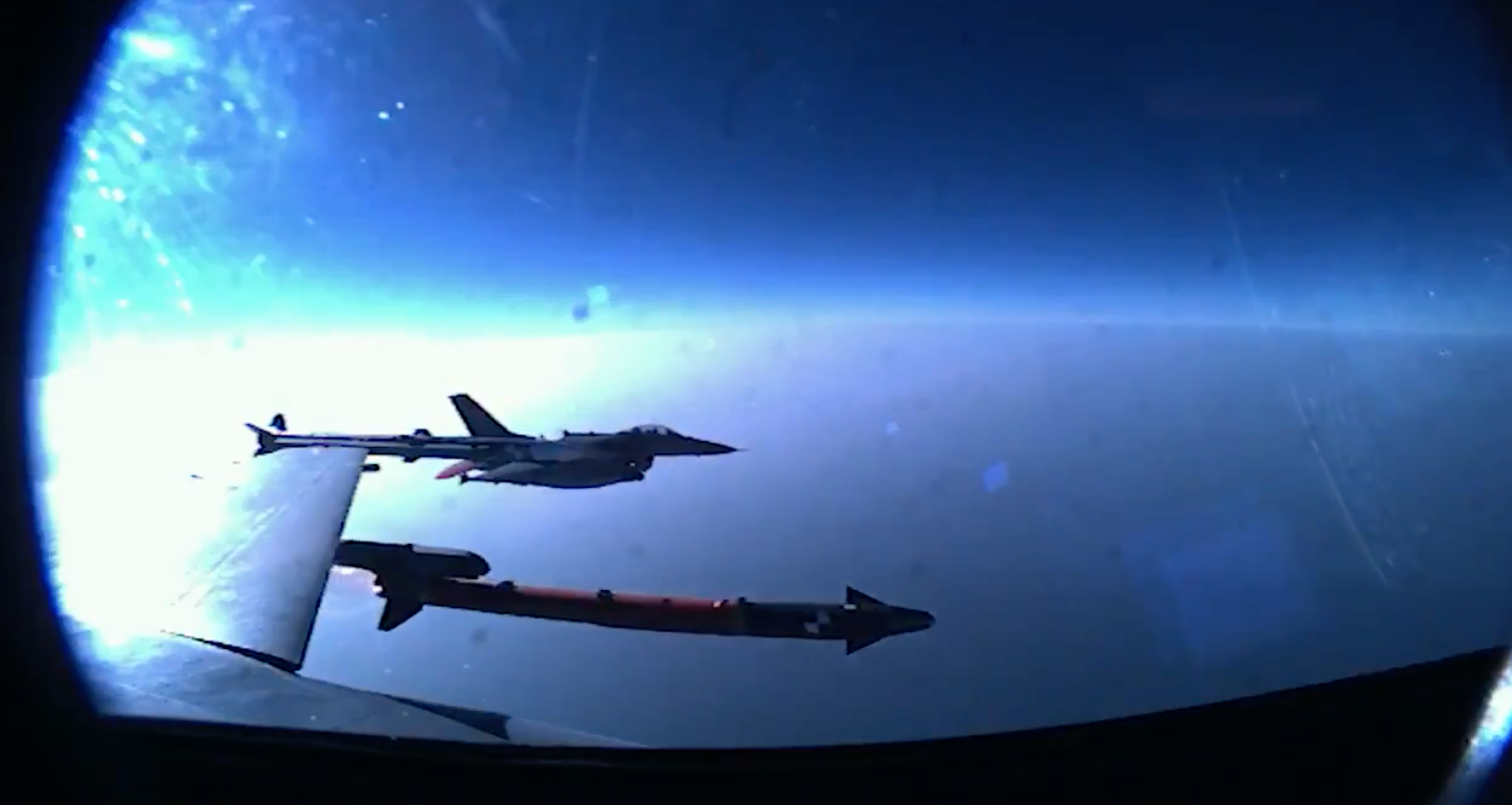
TURKISH DEFENSE INDUSTRY SCREENCAP
Launch of the Bozdoğan.
The heat-seeking missile is just under 11 feet long, weighs around 300 pounds, and can reportedly hit targets as far away as 15 miles. No datalink is fitted but it has been suggested it could be added in the future, which would provide for lock-on after launch, or LOAL, capability. This is a capability that is critical for stealthy aircraft that carry their weapons concealed in internal bays, but also gives the weapon additional flexibility when launched from non-stealthy platforms.

TURKISH DEFENSE INDUSTRY SCREENCAP
Radar tracks showing the path of the Bozdoğan after launch from the F-16, heading toward the Şimşek target.
More air launches of the Bozdoğan are planned for this year, with the goal of starting initial production in 2022. That task is likely to be handled by Roketsan, a Turkish firm responsible for a range of munitions, including diverse air-launched weapons.
Bozdoğan is also just one part of TÜBİTAK SAGE's Göktuğ air-to-air missile program, which is also working on the beyond-visual-range Gökdoğan missile, inert examples of which were also carried on the wingtips of the F-16 involved in the recent test. The Gökdoğan — which means peregrine — features radar guidance and will reportedly have a range of around 40 miles.
While the Bozdoğan is slated to eventually replace the AIM-9 Sidewinder in the Turkish Air Force inventory, the Gökdoğan is planned to supersede the AIM-120 AMRAAM.
The Bozdoğan and the Gökdoğan have been in development since around 2013 and were revealed to the public at the International Defense Industry Fair (IDEF) that took place in Istanbul in 2017. Test launches from the ground were conducted in 2018 and 2019, culminating in engagements against Banshee target drones, involving prototype missiles without warheads fitted. Captive carry flight testing began last year.
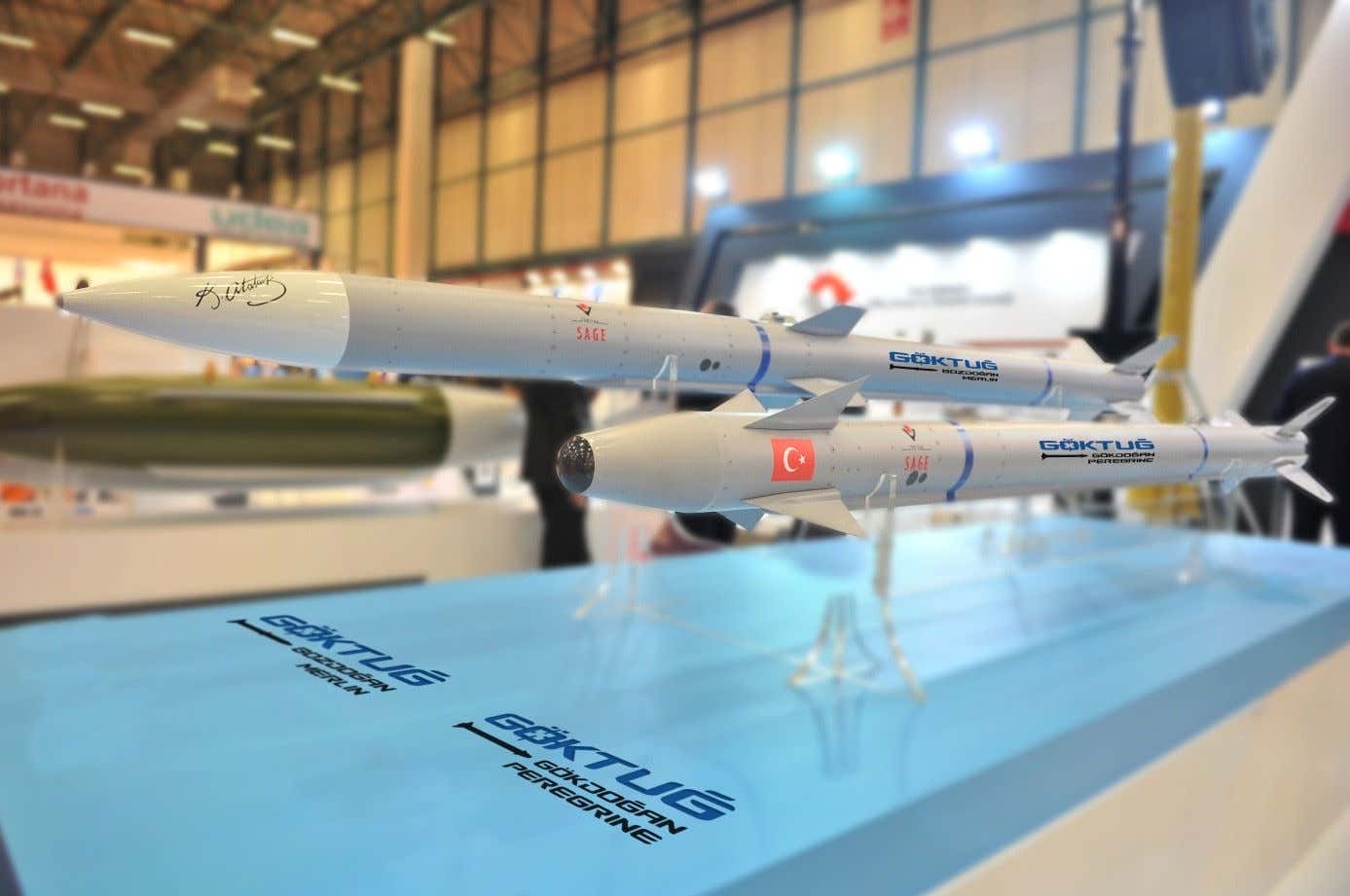
TÜBİTAK SAGE
The two missiles being developed under the Göktuğ program, Bozdoğan, in front, and Gökdoğan, at rear.
Securing a local source of air-to-air missiles is all the more important since Turkey began to be “unwound” from the F-35 program amid a breakdown in military relations with the U.S. centered on Ankara’s acquisition of the Russian-made S-400 air defense system. With an eye toward potential U.S. sanctions, Turkey had already reportedly begun stockpiling spare parts for its F-16s, and other unspecified military systems, in July 2019. The same year, lawmakers in the U.S. House of Representatives agreed to a non-binding resolution outlining a number of potential courses of action against Turkey, specifically mentioning the F-16, as well as the CH-47F Chinook heavy-lift helicopter, and the UH-60 Black Hawk utility helicopter.
It’s not immediately clear how President Joe Biden will deal with the military relationship with Turkey, but there are signs, at least, that the stance may be softening, albeit with continued calls for Ankara to abandon the S-400.
Regardless, successfully integrating the new missiles onto the F-16 — which will be the backbone of the Turkish Air Force for years to come — is not necessarily easy. Defence Turkey pointed out that the first Bozdoğan flight test launch involved an older F-16, which had not undergone an avionics upgrade. While Turkey has access to the source codes for the mission computers on these jets, the same is not true for the modernized jets and, likely, the most advanced Block 52 and 52+ aircraft.
While the integration of the two missiles on the non-modernized F-16 Block 30 and Block 40 jets should not present major difficulties, adding the radar-guided Gökdoğan, in particular, to the updated jets could be tricky since this weapon needs to receive in-flight updates from the AN/APG-68 radar.
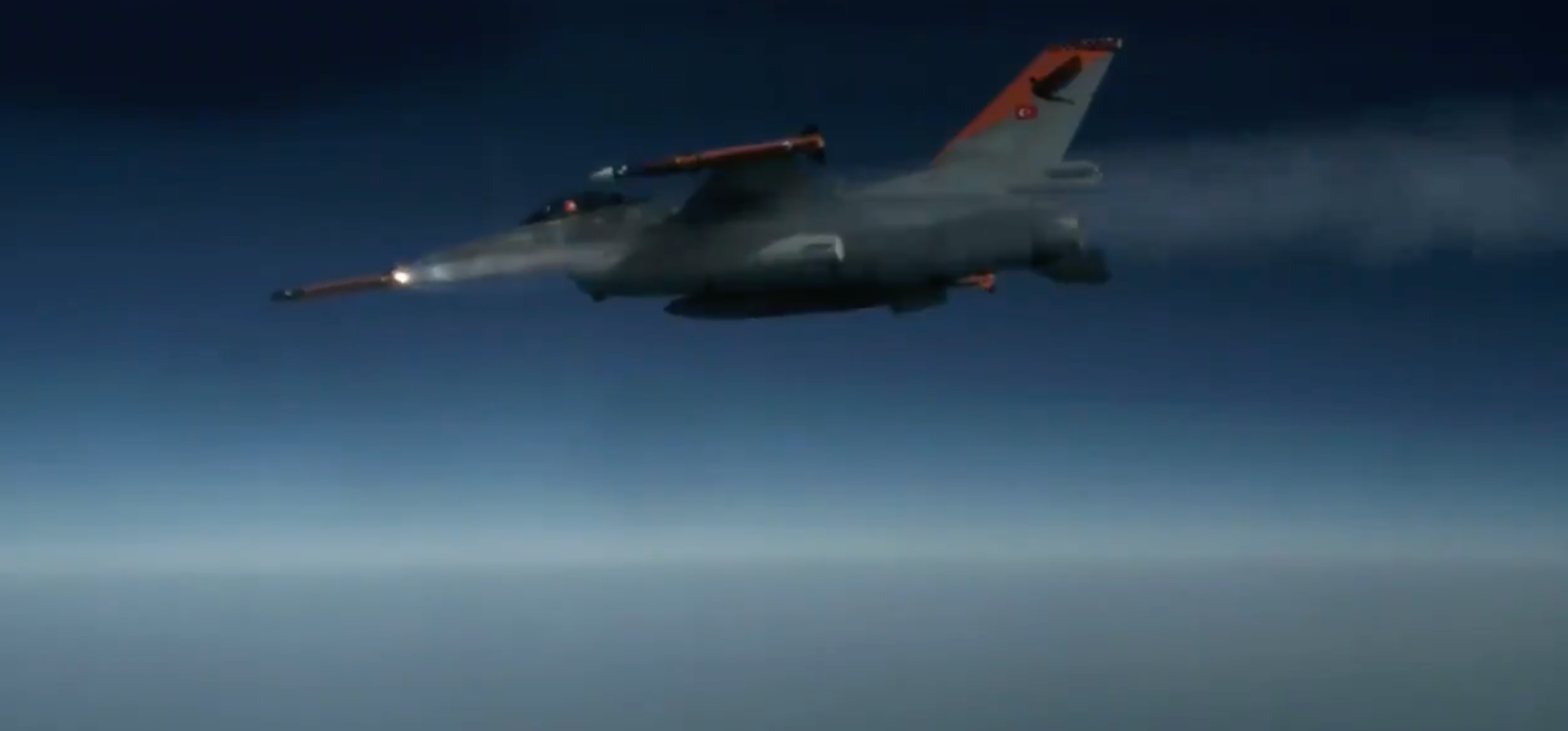
TURKISH DEFENSE INDUSTRY SCREENCAP
However, even if the new missiles are limited to the less advanced jets — to start with, at least — an indigenous service-life extension, performed by Turkish Aerospace, should ensure that these older jets can remain in service longer, increasing airframe lifespan to 12,000 hours. Indeed, this structural improvement program is focusing on the oldest Block 30 jets that began to be delivered in 1987. These should be ideal for the integration of these Turkish-made missiles.
There is also the possibility that the Bozdoğan, and the Gökdoğan, too, could attract interest among export customers. Turkey is well established as a provider of increasingly sophisticated weapons systems and subsystems and, although the air-to-air missile market is relatively crowded, the Turkish weapons would not be subject to the possible restrictions imposed by the U.S. International Traffic in Arms Regulations (ITAR) guidelines, which can limit the transfer of defense and military technologies and services to certain countries.
While the Turkish Aerospace Hürjet and TF-X are still in the development phase, being able to offer them to potential foreign customers together with integrated weapons options would also be a significant advantage. It would put Turkey among a select group of countries able to offer a complete package of combat aircraft and related weapons, which also include precision-guided air-to-ground munitions, some of which have standoff range.
The Bozdoğan, and subsequently the Gökdoğan, should provide Turkey with yet more independence in its F-16 operations while continuing to expand its arms industries into new areas. Exactly how feasible it will be to integrate these new weapons across the Turkish F-16 fleet remains to be seen, however.

Turkish F-16 Knocks Down Target Drone With New Indigenous Air-To-Air Missile
The test of Turkey’s first domestically designed air-to-air missile reflects the country’s increasing ability to produce more advanced weaponry.
Combat-Master
Baklava Consumer
Turkish F-16 Knocks Down Target Drone With New Indigenous Air-To-Air Missile
Turkey’s plan to introduce indigenous new-generation air-to-air missiles has reached an important milestone with the first successful air launch of the short-range Bozdoğan weapon. A Turkish Air Force F-16C Block 40 fighter jet recently fired one of these missiles, destroying a Turkish Aerospace Şimşek high-speed target drone. The heat-seeking Bozdoğan, developed under a two-part air-to-air missile program by TÜBİTAK Defense Industries Research and Development Institute, or TÜBİTAK SAGE, is intended to arm Turkish F-16s, and Turkish Aerospace’s forthcoming Hürjet advanced jet trainer and light attack aircraft, as well as the future TF-X advanced fighter jet.
Reports from Turkey indicate that the initial air-launch test of the Bozdoğan — Turkish for merlin, a small bird of prey — was carried out at the missile test range in the country’s Sinop province, on the Black Sea coast. This is the same facility that hosted trials of the Russian-made S-400 surface-to-air missile system last year. The F-16 came from the Turkish Air Force’s 401 Squadron, the service’s test unit. According to the Defence Turkey website, the missile launch and engagement sequence was monitored both from the ground and by accompanying F-16s, at least one of which carried a Sniper targeting pod.

TURKISH DEFENSE INDUSTRY SCREENCAP
An F-16C test jet armed with the short-range Bozdoğan under the wing, and the medium-range Gökdoğan on the wingtip station.
Video released showing the test reveals that the Bozdoğan’s infrared seeker head locked onto the target drone at around 9 miles and was launched at a distance of between 3 and 5 miles from the target.
President Recep Erdoğan announced the successful missile test on Twitter yesterday, sharing a video and noting that Turkey had now joined a select group of countries that have successfully developed air-to-air missile technology.
The Bozdoğan, which is broadly similar in appearance to the latest AIM-9X Sidewinder, features a high-resolution dual-color imaging infrared (IIR) seeker. Like other missiles in its class, it offers a high off-boresight capability, thrust-vectoring controls, and its seeker has a high degree of discrimination to defeat flares and other countermeasures systems, according to the manufacturer.

TURKISH DEFENSE INDUSTRY SCREENCAP
Launch of the Bozdoğan.
The heat-seeking missile is just under 11 feet long, weighs around 300 pounds, and can reportedly hit targets as far away as 15 miles. No datalink is fitted but it has been suggested it could be added in the future, which would provide for lock-on after launch, or LOAL, capability. This is a capability that is critical for stealthy aircraft that carry their weapons concealed in internal bays, but also gives the weapon additional flexibility when launched from non-stealthy platforms.

TURKISH DEFENSE INDUSTRY SCREENCAP
Radar tracks showing the path of the Bozdoğan after launch from the F-16, heading toward the Şimşek target.
More air launches of the Bozdoğan are planned for this year, with the goal of starting initial production in 2022. That task is likely to be handled by Roketsan, a Turkish firm responsible for a range of munitions, including diverse air-launched weapons.
Bozdoğan is also just one part of TÜBİTAK SAGE's Göktuğ air-to-air missile program, which is also working on the beyond-visual-range Gökdoğan missile, inert examples of which were also carried on the wingtips of the F-16 involved in the recent test. The Gökdoğan — which means peregrine — features radar guidance and will reportedly have a range of around 40 miles.
While the Bozdoğan is slated to eventually replace the AIM-9 Sidewinder in the Turkish Air Force inventory, the Gökdoğan is planned to supersede the AIM-120 AMRAAM.
The Bozdoğan and the Gökdoğan have been in development since around 2013 and were revealed to the public at the International Defense Industry Fair (IDEF) that took place in Istanbul in 2017. Test launches from the ground were conducted in 2018 and 2019, culminating in engagements against Banshee target drones, involving prototype missiles without warheads fitted. Captive carry flight testing began last year.

TÜBİTAK SAGE
The two missiles being developed under the Göktuğ program, Bozdoğan, in front, and Gökdoğan, at rear.
Securing a local source of air-to-air missiles is all the more important since Turkey began to be “unwound” from the F-35 program amid a breakdown in military relations with the U.S. centered on Ankara’s acquisition of the Russian-made S-400 air defense system. With an eye toward potential U.S. sanctions, Turkey had already reportedly begun stockpiling spare parts for its F-16s, and other unspecified military systems, in July 2019. The same year, lawmakers in the U.S. House of Representatives agreed to a non-binding resolution outlining a number of potential courses of action against Turkey, specifically mentioning the F-16, as well as the CH-47F Chinook heavy-lift helicopter, and the UH-60 Black Hawk utility helicopter.
It’s not immediately clear how President Joe Biden will deal with the military relationship with Turkey, but there are signs, at least, that the stance may be softening, albeit with continued calls for Ankara to abandon the S-400.
Regardless, successfully integrating the new missiles onto the F-16 — which will be the backbone of the Turkish Air Force for years to come — is not necessarily easy. Defence Turkey pointed out that the first Bozdoğan flight test launch involved an older F-16, which had not undergone an avionics upgrade. While Turkey has access to the source codes for the mission computers on these jets, the same is not true for the modernized jets and, likely, the most advanced Block 52 and 52+ aircraft.
While the integration of the two missiles on the non-modernized F-16 Block 30 and Block 40 jets should not present major difficulties, adding the radar-guided Gökdoğan, in particular, to the updated jets could be tricky since this weapon needs to receive in-flight updates from the AN/APG-68 radar.

TURKISH DEFENSE INDUSTRY SCREENCAP
However, even if the new missiles are limited to the less advanced jets — to start with, at least — an indigenous service-life extension, performed by Turkish Aerospace, should ensure that these older jets can remain in service longer, increasing airframe lifespan to 12,000 hours. Indeed, this structural improvement program is focusing on the oldest Block 30 jets that began to be delivered in 1987. These should be ideal for the integration of these Turkish-made missiles.
There is also the possibility that the Bozdoğan, and the Gökdoğan, too, could attract interest among export customers. Turkey is well established as a provider of increasingly sophisticated weapons systems and subsystems and, although the air-to-air missile market is relatively crowded, the Turkish weapons would not be subject to the possible restrictions imposed by the U.S. International Traffic in Arms Regulations (ITAR) guidelines, which can limit the transfer of defense and military technologies and services to certain countries.
While the Turkish Aerospace Hürjet and TF-X are still in the development phase, being able to offer them to potential foreign customers together with integrated weapons options would also be a significant advantage. It would put Turkey among a select group of countries able to offer a complete package of combat aircraft and related weapons, which also include precision-guided air-to-ground munitions, some of which have standoff range.
The Bozdoğan, and subsequently the Gökdoğan, should provide Turkey with yet more independence in its F-16 operations while continuing to expand its arms industries into new areas. Exactly how feasible it will be to integrate these new weapons across the Turkish F-16 fleet remains to be seen, however.

Turkish F-16 Knocks Down Target Drone With New Indigenous Air-To-Air Missile
The test of Turkey’s first domestically designed air-to-air missile reflects the country’s increasing ability to produce more advanced weaponry.www.thedrive.com
A well researched article, bravo to the writer.
RDX, HMX and CXM production facility
200 ton/year
200 ton/year
On existing fighters it will be a lot harder to get them integrated for a few different reasons, but for Turkish made jets yeah they would work.There is also the possibility that the Bozdoğan, and the Gökdoğan, too, could attract interest among export customers. Turkey is well established as a provider of increasingly sophisticated weapons systems and subsystems and, although the air-to-air missile market is relatively crowded, the Turkish weapons would not be subject to the possible restrictions imposed by the U.S. International Traffic in Arms Regulations (ITAR) guidelines, which can limit the transfer of defense and military technologies and services to certain countries.
T.R. Minister of Industry and Technology released video footage of KGK-SİHA-82 hitting its target, launched from TAI AKSUNGUR
> Including Cyberpunk 2077 Soundtrack
> Why didn't TAI include the BOMB hitting its target in their promotional Video ???
> Including Cyberpunk 2077 Soundtrack
> Why didn't TAI include the BOMB hitting its target in their promotional Video ???
They did.T.R. Minister of Industry and Technology released video footage of KGK-SİHA-82 hitting its target, launched from TAI AKSUNGUR
> Including Cyberpunk 2077 Soundtrack
> Why didn't TAI include the BOMB hitting its target in their promotional Video ???
The wing deployment and target part is from F-16 MK-83 KGK tests. Maybe they simply do not have the footage of the target.T.R. Minister of Industry and Technology released video footage of KGK-SİHA-82 hitting its target, launched from TAI AKSUNGUR
> Including Cyberpunk 2077 Soundtrack
> Why didn't TAI include the BOMB hitting its target in their promotional Video ???
Can you proof your claiming?The wing deployment and target part is from F-16 MK-83 KGK tests. Maybe they simply do not have the footage of the target.
For completeness:Can you proof your claiming?
Not nitpicking, nice video, but the wing deployment and target part is from the F-16 MK-83 KGK test.
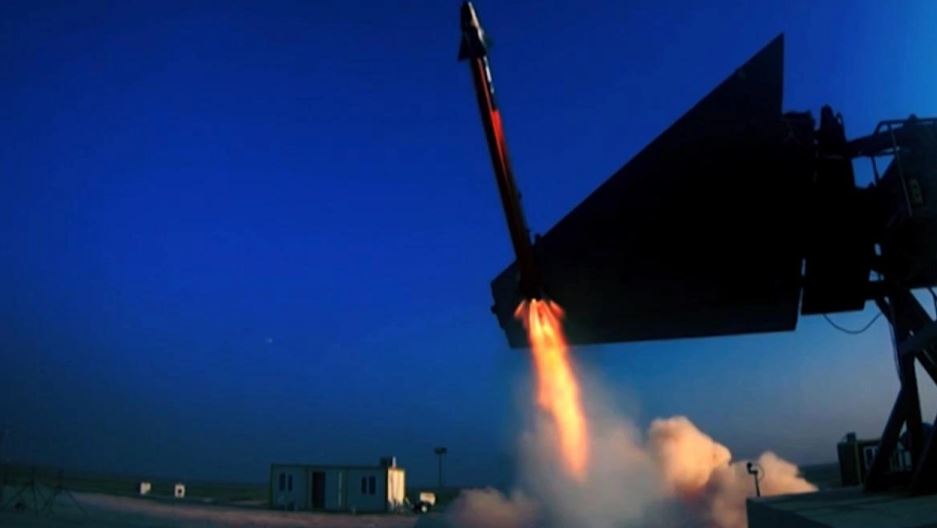
Gökyüzüne Türk damgası: Dünyadaki rakiplerinden çok daha güçlü
Bozdoğan ve Gökdoğan’ın yurtdışındaki emsallerine kıyasla bazı noktalarda daha güçlü özelliklerinin olduğunu vurgulayan TÜBİTAK SAGE Enstitüsü Müdürü Okumuş, ‘Proje tamamlandıktan sonra mutlaka Faz-2 ve Faz-3 şeklinde üretimimiz söz konusu olacak.’ ifadelerini kullandı. Türkiye’nin savunma...
 m5dergi.com
m5dergi.com
He reiterated that by making these missiles capable for Akinci UAV launch, a first in a2a missiles will be achieved. He also pointed out that, in spite of the high specifications these missiles have, once current ones are completed, there will definitely be block2 and block3 versions.
As per below link, Sage is planning a missile with much bigger rocket engine and it all seem to lead towards a missile like amraam-er.
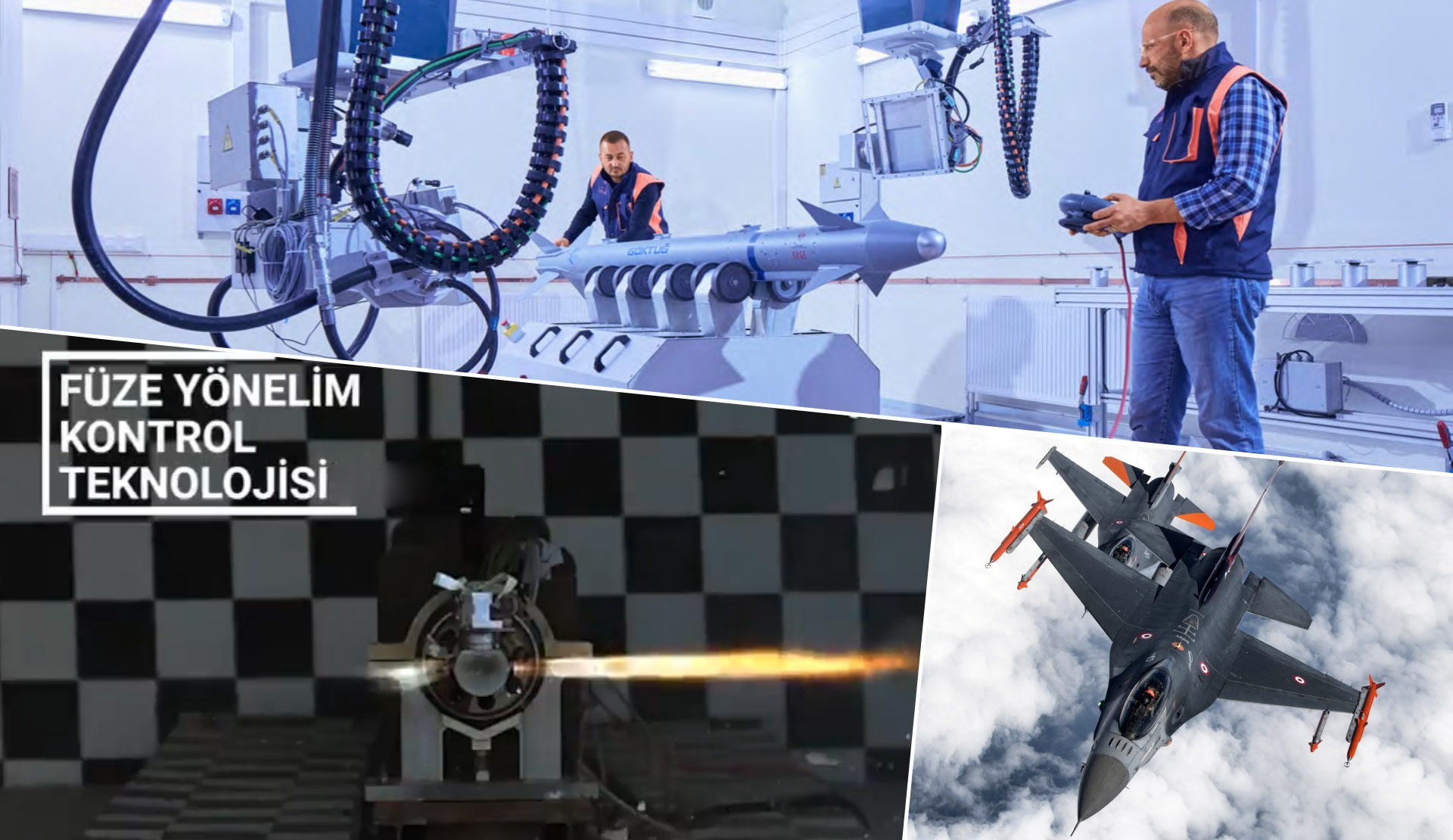
TÜBİTAK SAGE hava odaklı füzelerde "teknosistem" oluşturuyor
SAGE'nin sadece kamuoyuna açık geliştirme çalışmalarına dahi bakıldığında dahi sadece ürünler ortaya çıkmadığı bir "ekosistem" oluşturduğu görülüyor.
 www.defenceturk.net
www.defenceturk.net
i don't think this is a proof but can be inspected drop angle of the bomb etc. must be a technical proofFor completeness:
See my post in other thread:i don't think this is a proof but can be inspected drop angle of the bomb etc. must be a technical proof
Just watch and pause the videos. The same bird to the left and down side of KGK. Wave pattern is the same. Same for the wing deployment part.
View attachment 19443 View attachment 19444
Last edited:
Correction:Tubitak-Sage Institute Manager Gurcan Okumus has pointed out that the Bozdogan and Gokdogan a2a missiles have got quite a few properties that surpass their current competitors’ capabilities. (Although he did not give details)
Gökyüzüne Türk damgası: Dünyadaki rakiplerinden çok daha güçlü
Bozdoğan ve Gökdoğan’ın yurtdışındaki emsallerine kıyasla bazı noktalarda daha güçlü özelliklerinin olduğunu vurgulayan TÜBİTAK SAGE Enstitüsü Müdürü Okumuş, ‘Proje tamamlandıktan sonra mutlaka Faz-2 ve Faz-3 şeklinde üretimimiz söz konusu olacak.’ ifadelerini kullandı. Türkiye’nin savunma...m5dergi.com
He reiterated that by making these missiles capable for Akinci UAV launch, a first in a2a missiles will be achieved. He also pointed out that, in spite of the high specifications these missiles have, once current ones are completed, there will definitely be block2 and block3 versions.
As per below link, Sage is planning a missile with much bigger rocket engine and it all seem to lead towards a missile like amraam-er.

TÜBİTAK SAGE hava odaklı füzelerde "teknosistem" oluşturuyor
SAGE'nin sadece kamuoyuna açık geliştirme çalışmalarına dahi bakıldığında dahi sadece ürünler ortaya çıkmadığı bir "ekosistem" oluşturduğu görülüyor.www.defenceturk.net
Gurcan Okumus has said that Bozdogan can lock on to it’s target quicker than aim9x. (4.40th min)
Turkey will replace APG-68 radar and the old mission computer with the Aselsan AESA radar and the national mission computer.On existing fighters it will be a lot harder to get them integrated for a few different reasons, but for Turkish made jets yeah they would work.
For foreign jets wouldn't you need OEM approval? That was my basis off saying it would be harder to do.Turkey will replace APG-68 radar and the old mission computer with the Aselsan AESA radar and the national mission computer.
I think if they were willing to allow you to put your radar into another countries F-16s for example they would rather sell F-16V upgrades and make money.
Remember Israel trying to sell F-16s to Croatia?
"But Washington objected to the sale, apparently on the grounds that Israel’s upgrades made the planes more attractive to buyers than their American counterparts. It said Israel needed to strip off the upgrades made to the US-made jets, including electronic and radar systems."
Last edited:
But the Harpy is only ground launched weapon unlike the rest.
Furthermore SOMs are upside down in figures unlike the rest.
The man/woman should have sufficient knowledge before creating such things.






